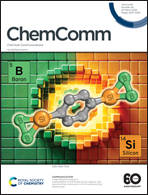Metallic radionuclide-labeled tetrameric 2,6-diisopropylphenyl azides for cancer treatment†
Abstract
This study proposes a new method for radionuclide therapy that involves the use of oligomeric 2,6-diisopropylphenyl azides and a chelator to form stable complexes with metallic radionuclides. The technique works by taking advantage of the endogenous acrolein produced by cancer cells. The azides react with the acrolein to give a diazo derivative that immediately attaches to the nearest organelle, effectively anchoring the radionuclide within the tumor. Preliminary in vivo experiments were conducted on a human lung carcinoma xenograft model, demonstrating the feasibility of this approach for cancer treatment.



 Please wait while we load your content...
Please wait while we load your content...